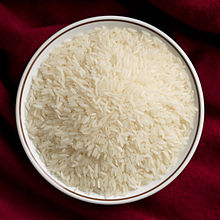
Back Jasmínová rýže Czech Jasminreis German Arroz jazmín Spanish Jasmiiniriisi Finnish Riz thaï French אורז יסמין HE जैस्मिन राइस Hindi Beras melati ID Jasmine (riso) Italian ジャスミン米 Japanese
| Jasmine rice | |
|---|---|
 Close-up of uncooked grains | |
| Species | Oryza sativa[1] |
| Cultivar group | Jasmine |
| Cultivar | KDML105, etc.[1] |
| Origin | Thailand |
Jasmine rice (Thai: ข้าวหอมมะลิ; RTGS: Khao hom mali; Thai pronunciation: [kʰâːw hɔ̌ːm malíʔ]) is a long-grain variety of fragrant rice (also known as aromatic rice). Its fragrance, reminiscent of pandan (Pandanus amaryllifolius) and popcorn,[2] results from the rice plant's natural production of aroma compounds, of which 2-acetyl-1-pyrroline is the most salient.[3] A rapid loss of aromatic intensity leads many Southeast Asians and connoisseurs to prefer each year's freshly harvested "new crop" of jasmine rice.[4] Jasmine rice is a variety of Oryza sativa.[1]
Jasmine rice is grown primarily in Thailand (Thai hom mali or Thai fragrant rice),[5] Cambodia (phka rumduol or Cambodian jasmine rice),[6] Laos, and southern Vietnam. It is moist and soft in texture when cooked, with a slightly sweet flavor. The grains cling and are somewhat sticky when cooked, though less sticky than glutinous rice (Oryza sativa var. glutinosa), as it has less amylopectin. It is about three times stickier than American long-grain rice.
To harvest jasmine rice, the long stalks are cut and threshed. The rice can then be left in a hulled form called paddy rice, de-hulled to produce brown rice, or milled to remove the germ and some or all of the bran, producing white rice.
Jasmine rice is not directly related to the shrub of the same name.
- ^ a b c Yoolong, Suranan; Kruasuwan, Worarat; Thanh Phạm, Huyền Thị; Jaemsaeng, Ratchaniwan; Jantasuriyarat, Chatchawan; Thamchaipenet, Arinthip (2019-02-04). "Modulation of salt tolerance in Thai jasmine rice (Oryza sativa L. cv. KDML105) by Streptomyces venezuelae ATCC 10712 expressing ACC deaminase". Scientific Reports. 9 (1): 1275. doi:10.1038/s41598-018-37987-5. ISSN 2045-2322. PMC 6361907. PMID 30718781.
- ^ Uraiwan Tanchotikul (1991). "An improved method for quantification of 2-acetyl-1-pyrroline, a "popcorn"-like aroma, in aromatic rice by high-resolution gas chromatography/mass spectrometry/selected ion monitoring". J. Agric. Food Chem. 39 (5): 944–947. doi:10.1021/jf00005a029.
- ^ S. Wongpornchai (2003). "Identification and quantitation of the rice aroma compound, 2-acetyl-1-pyrroline, in bread flowers (Vallaris glabra Ktze)". J. Agric. Food Chem. 51 (2): 457–462. doi:10.1021/jf025856x. PMID 12517110.
- ^ Gershenson, Lisa (Winter 2015). "New Crop Rice". Cook's Gazette. Retrieved February 2, 2016.
- ^ Somnuk, Weerawat; Buddhajak, Smanachan; Sunsuk, Donlawat; Saefad, Somchai (28 February 2021). "The Struggle of Thung Kula Rice Farmers to Grow Hom Mali Rice". Prachatai English. Retrieved 30 March 2021.
- ^ Kossov, Igor (5 May 2015). ""World's Best Rice" Struggles for Recognition". Khmer Times. Retrieved 30 March 2021.
© MMXXIII Rich X Search. We shall prevail. All rights reserved. Rich X Search